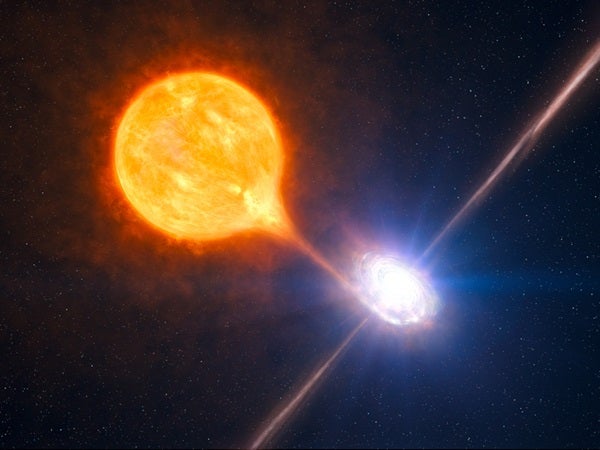Combining observations made with the European Southern Observatory’s (ESO) Very Large Telescope (VLT) and NASA’s Chandra X-ray telescope, astronomers have uncovered the most powerful pair of jets seen from a stellar black hole. This object, also known as a microquasar, blows a huge bubble of hot gas that is 1,000 light-years across, twice as large and more powerful than other known microquasars.
“We have been astonished by how much energy is injected into the gas by the black hole,” said Manfred Pakull from the University of Strasbourg, France. “This black hole is just a few solar masses, but it is a real miniature version of the most powerful quasars and radio galaxies, which contain black holes with masses of a few million times that of the Sun.”
Black holes are known to release a prodigious amount of energy when they swallow matter. It was thought that most of the energy came out in the form of radiation, predominantly X-rays. However, the new findings show that some black holes can release at least as much energy, and perhaps more, in the form of collimated jets of fast moving particles. The fast jets slam into the surrounding interstellar gas, heating it and triggering an expansion. The inflating bubble contains a mixture of hot gas and ultra-fast particles at different temperatures. Observations in several energy bands (optical, radio, X-rays) help astronomers calculate the total rate at which the black hole is heating its surroundings.
The astronomers could observe the spots where the jets smash into the interstellar gas located around the black hole and reveal that the bubble of hot gas is inflating at a speed of almost 621,000 mph(1 million km/h).
“The length of the jets in NGC 7793 is amazing compared to the size of the black hole from which they are launched,” said Robert Soria from University College London, United Kingdom. “If the black hole were shrunk to the size of a soccer ball, each jet would extend from Earth to beyond the orbit of Pluto.”
This research will help astronomers understand the similarity between small black holes formed from exploded stars and the supermassive black holes at the centers of galaxies. Very powerful jets have been seen from supermassive black holes, but they are thought to be less frequent in the smaller microquasar variety. The new discovery suggests that many of them may simply have gone unnoticed so far.
The gas-blowing black hole is located 12 million light-years away, in the outskirts of the spiral galaxy NGC 7793. From the size and expansion velocity of the bubble, the astronomers have found that the jet activity must have been ongoing for at least 200,000 years.










